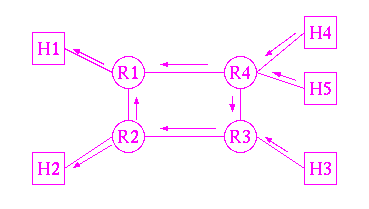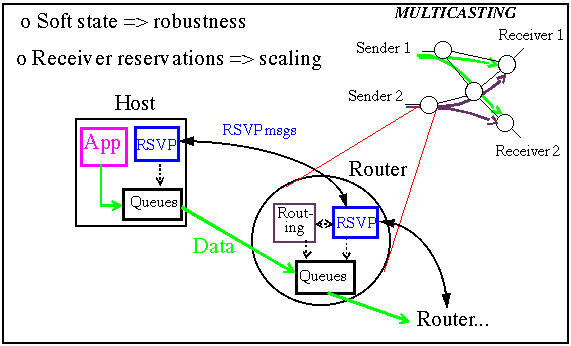
RSVP
ReSerVation setup Protocol
New RSVP Release version 3.2 - See Below
WHAT IS RSVP?
RSVP is a network control protocol that will allow Internet
applications to obtain special qualities-of-service (QoS's) for their
data flows. This will generally (but not necessarily) require
reserving resources along the data path(s). RSVP is a component of the
future "integrated services" Internet, which will provide both
best-effort and realtime qualities of service [
RSVP93,
ISInt93
]
.
When an application in a host (end system) requests a specific QoS for
its data stream, RSVP is used to deliver the request to each router
along the path(s) of the data stream and to maintain router and host
state to provide the requested service. Although RSVP was developed
for setting up resource reservations, it is readily adaptable to
transport other kinds of metwork control information along data flow
paths.
WHERE IS RSVP BEING DEVELOPED AND STANDARDIZED?
RSVP design has been a joint effort involving
Xerox PARC
,
MIT,
the
USC Information Sciences Institute
, and
USC Computer Science Department
. There is an
RSVP working group
of the
IETF
to agree on an Internet standard
specification for RSVP.
IETF RSVP WORKING GROUPS
RSVP Mailing list: rsvp@isi.edu.
To join list, send request to rsvp-request@isi.edu
RSVP WG Co-chairs: Bob Braden (braden@isi.edu) and
Lixia Zhang (lixia@parc.xerox.com)
Most recent protcol specification document: See bibliography below
The job of the RSVP working group dovetails, and sometimes overlaps,
the area covered by the Integrated Services (int-serv) working group.
If you join the RSVP mailing list, we recommend you also join the
int-serv mailing list:
Int-serv Mailing list: int-serv@isi.edu.
To join list, send request to int-serv-request@isi.edu
Int-serv WG Co-chairs: Craig Partridge (craig@aland.bbn.com),
Dave Clark (ddc@lcs.mit.edu),
Scott Shenker (shenker@parc.xerox.com),
John Wroclawski (jtw@lcs.mit.edu)
RSVP BIBLIOGRAPHY
[SPEC95]
Braden, R., Zhang, L., Berson, S., Herzog, S., Wroclawski, J.,
Resource ReSerVation Protocol (RSVP) -- Version 1 Functional Specification
(also in
postscript)
Internet Draft.
[RSVP93]
Zhang, L., Deering, S., Estrin, D., Shenker, S., and D. Zappala,
"RSVP: A New Resource ReSerVation Protocol",
IEEE Network, September 1993.
[RSVP94]
Braden, R. and L. Zhang, "RSVP: A Resource ReSerVation Protocol",
Connexions, ? 1994.
[MITZ94a]
Mitzel, D., Estrin, D., Shenker, S., and L. Zhang,
"An Architectural Comparison of ST-II and RSVP",
Proceedings of Infocomm '94.
[MITZ94b]
Mitzel, D., Shenker, S.,
"Asymptotic Resource Consumption in Multicast Reservation Styles",
Proceedings of ACM SIGCOMM '94.
[MITZ95]
Mitzel, D., Estrin, D. Shenker, S., Zhang, L.
"A Study of Reservation Dynamics in Integrated Services Packet Networks",
Submitted for publication.
[ISInt93]
Braden, R., Clark, D., and S. Shenker,
"Integrated Services in the Internet Architecture: an Overview"
RFC1633, ISI, MIT, and PARC, June 1994.
[BAKE95]
Baker, F.,
"RSVP Cryptographic Authentication,"
Internet Draft.
[BAKE95]
Baker, F., Krawczyk, J.
"RSVP Management Information Base,"
Internet Draft.
[HERZ95]
Herzog, S.,
"Building Blocks for Accounting and Access Control in RSVP,"
Pre-Internet Draft.
[HERZ95]
Herzog, S., Shenker, S., Estrin, D.,
"Sharing the Cost of Multicast Trees: An Axiomatic Analysis",
Proceedings of SIGCOMM '95.
WHAT DOES RSVP DO?
- RSVP supports multicast or unicast simplex data delivery
-
RSVP is fundamentally designed for multicasting
as well as unicasting, and it treats data flow
as one directional. It distinguishes the roles
of data sender (e.g., hosts H1, H2) from data
receiver (hosts H3, H4, H5), although in many
cases the same application will play both roles.

- RSVP handles heterogeneous receivers
-
Different hosts on the same multicast delivery
tree may have different capabilities and
therefore need different QoS.
- RSVP is receiver-oriented.
-
To efficiently handle heterogeneous receivers and dynamic group
membership, RSVP makes receivers responsible for requesting
resource reservations. Each receiver can request a QoS that is
tailored to its particular requirement, by sending RSVP
reservation messages upstream towards the senders.
This figure shows RSVP reservation
messages flowing upstream. Just as
the data branches out in routers
R1, R3, and R4, so the reservation
messages going upstream are "merged".
Thus, a single reservation message
need only flow upstream until it is
merged with another reservation.

- RSVP adapts to changing group membership as well as changing routes.
-
For dynamic adaptability and robustness, RSVP maintains ``soft
state'' in the routers. The only permanent state is in the end
systems, which periodically send their RSVP control messages to
refresh the router state. In the absence of refresh, RSVP state
in routers will time out and be deleted.
- RSVP is not a routing protocol.
-
The RSVP daemon consults the local routing protocol(s) to obtain
routes. RSVP is designed to operate with existing and future
unicast and multicast routing protocols. Thus, a host sends IGMP
messages to join a multicast group, but it uses RSVP messages to
reserve resources along the delivery path(s) from that group.
Further discussion on the objectives and general justification for
RSVP design are presented in [
RSVP93
,
ISInt93
].
HOW DOES RSVP WORK?
As shown in this figure, each router in the path capable of resource
reservation will pass incoming data packets to a Packet Classifier and
then queue them in a Packet Scheduler. The Packet Classifier determines
the route and the QoS class for each packet. The Scheduler allocates a
particular outgoing link for packet transmission (it may also allocate
other system resources (e.g., CPU time and/or buffers).

A QoS request originating in an application is passed to the RSVP
implementation (shown as a user daemon in the figure above) and
RSVP passes the request to all the nodes along the reverse data path(s)
to the destination(s). At each node, RSVP applies a local decision
procedure called admission control to the QoS request, and if
admission control succeeds, it sets the parameters to the Classifier
and Packet Scheduler to obtain the desired QoS. If admission control
fails at any node, RSVP returns an error indication to the
application.
RSVP reserves resources for simplex data streams, i.e., it
reserves resources in only one direction on a link, so that a sender is
logically distinct from a receiver. However, the same application may
act as both sender and receiver.
RSVP protocol mechanisms provide a general facility for creating and
maintaining distributed reservation state across a mesh of multicast
delivery paths. RSVP transfers reservation parameters as opaque data
(except for certain well-defined operations on the data), which it
simply passes to admission control and to the Packet Scheduler and
Classifier for interpretation.
RSVP and related software
Click
here
for the current release of RSVP software (based on the July '95
version of the spec) plus supporting tools and
applications. An early access experimental release of
Solaris RSVP/CBQ
(also based on the July '95) version of the spec)
has been made available by Sun Microsystems (note that the file is
12MB).
Other RSVP documents
A copy of the
wildcard filter looping write-up
is available.
IETF meeting slides are available for
Danvers
,
San Jose
,
Toronto
,
Stockholm
, and
Dallas
.
There is also some information including a
draft version of the new RSVP spec
reflecting many changes agreed to in Danvers.
See also the
RSVP Project at ISI Home Page
You are visitor
 since February 21, 1996
since February 21, 1996
Steven Berson
(berson@isi.edu)



